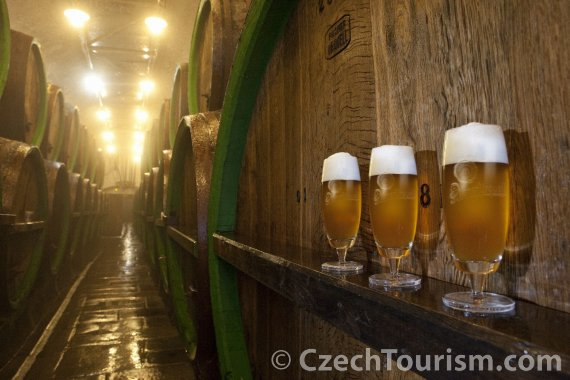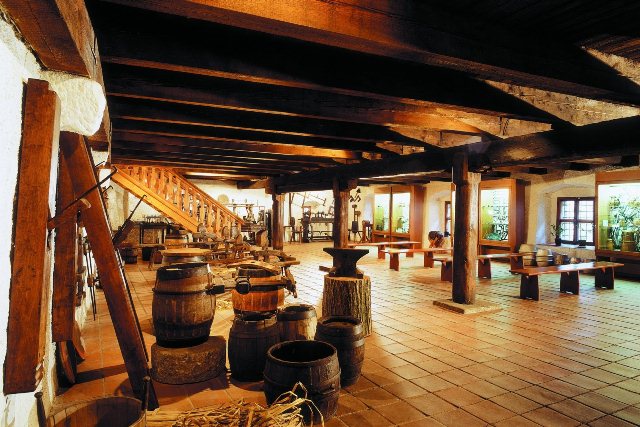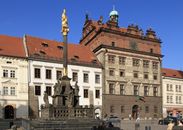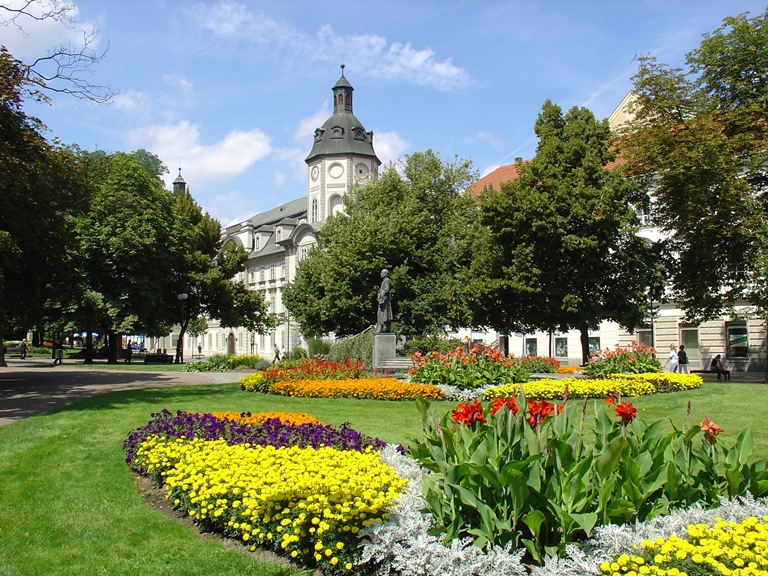
Plzeň - History in brief
The royal city of Pilsen was founded in 1295 by Wenceslas II at the confluence of four rivers – the Úhlava, Úslava, Radbuza and Mže. Its advantageous location at the crossroads of major trade routes contributed to the rapid economic development of the city, which soon became a centre of cultural and humanistic traditions. The high cultural and social level of the city is reflected in its unique building development. Valuable monuments include the Gothic St. Bartholomew’s Cathedral, the Renaissance town hall, a Franciscan monastery and a Jewish synagogue. During the age of industrialization in the 19th century, industrial giants, including the Skoda engineering complex and world-famous Pilsner Urquell brewery, were founded in the city. The founding of the University of West Bohemia and a bishopric added further cultural and spiritual dimensions to the city.
Plzeň – the European Capital of Culture 2015
Today, Pilsen covers 138 km2 and with nearly 170 thousand inhabitants it is the fourth largest city in the Czech Republic. Pilsen is the dynamic and modern metropolis of western Bohemia. It is home to many major firms and industrial companies, universities and medical schools. It has an extensive network of hotels and restaurants, as well as a rich cultural and sports programme and well-developed tourist infrastructure. Its exceptional quality was confirmed when it earned the title European Capital of Culture for 2015.
Plzeň – the Capital of Beer (everlasting and forever)

The Pilsner Urquell Brewery
The Pilsner Urquell Brewery, birthplace of the world-famous Pilsner Urquell beer, is the largest brewery in the Czech Republic. Beer has been brewed in Pilsen almost since the city’s inception. The Pilsner Urquell Brewery itself was founded and built through the joint effort of burghers with brewing rights. In 1842, in the former Burgher’s Brewery in Pilsen, the first bottom-fermented lager was brewed and before long it had conquered the whole world under the name Pilsner Urquell. Pilsner Urquell is a major manufacturer and exporter of Czech beer, exporting to more than 50 countries all over the world. The Pilsner Urquell Brewery is one of the most visited tourist sites of the city, with more than 250,000 visitors from around the world, passing through on guided tours annually.
www.prazdrojvisit.cz
Historical underground and Brewery Museum

Historical Underground
The Brewery Museum building is also a starting point for tours to the historical underground. The Pilsen Historical Underground originated from the time of founding the city itself and up to the 18th century was gradually linked to two or three-storey cellars. Its complex labyrinth of corridors, cellars and wells with the length of almost 20 km makes it one of the largest in the Central Europe. The cellars and corridors were used mainly for economic and technical purposes – as a store for food and barrels of beer. It was also used for workshops. The cellar contains a bookbinding exhibit with a medieval printing press that serves as a reminder of printing the Trojan Chronicle, the oldest printed book in Bohemia (Pilsen, 1468). A facsimile of it is on a display in the Education and Research Library of the Pilsen Region.
In the 16th century the waterworks was established in Pilsen. A water tower was built with a water machine that pumped water through wooden pipes to the fountains on the square. When replacing the floors, which were destroyed by floods in 2002, a pumping machine from the second half of the 19th century was discovered under the floor tiles. The original site was equipped with a replica water wheel made according to a design from 1875. The house with a late Gothic water tower at no. 19 (Pražská ulice – Prague Street) strengthened the defence function of the nearby Prague Gate as a part of the city’s fortification system. The old water tower was in operation until the late 19th century. Today, the cellar of the water tower is part of the Pilsen underground tour and offers views of a functional model of a water wheel.

Brewery Museum
The Brewery Museum located in the historical centre of the city is the only museum of its kind in the world, located in the original house with brewing rights from the 15th century. The house has been preserved in its original form, where the visitor can see a Gothic malt house, malt-drying kiln, rolling room, ice room, two-level cellars and parts of the former taproom. Hundreds of unique exhibits illustrate the history of brewing from ancient times to the present-day. In the vicinity of the Brewery Museum is one of the oldest pubs in Pilsen, Parkán. Its name is derived from its location in the space between the medieval city walls, called parkán.


foto: CzechTourism
Plzeň – sights of interest
The Republic Square with St. Bartholomew´s Cathedral
At the times of foundation of the city, the square, with dimensions of 139 x 193 m was one of the largest in Europe. It has undergone thorough renovations, gaining new flagstones as well as three new modern fountains, which portray heraldic figures from the Pilsen coat-of-arms: an angel, a camel, and a greyhound. To this day, the square is the main venue for cultural and open-air events and festivals. It is also the site of traditional markets. Together with its nearby vicinity, it invites visitors to the museums, galleries and historical sites or to enjoy romantic parks in the city centre.
The square is surrounded by rows of valuable historical houses, with Renaissance and Baroque modifications, often indicating the fast-growing wealth of their owners.
Town Hall
Directly on the Republic Square is a Renaissance jewel – the Town Hall, which has continued to serve its original purpose since its construction. It was built according to the plans of the Italian architect Giovanni de Statia in the years 1554-1559. The building is decorated with sgraffito displaying the city‘s coat-of-arms and Czech rulers. In the back room behind the mázhaus (foyer) there is a model of the historical centre of the city on a scale of 1:200 (free admission).

Plague Column
Right in front of the town hall stands a plague column with a Baroque replica of the Pilsen Madonna on the top. It was built in 1681 to protect the city from the plague, from which legendary Emperor Rudolf II fled to Pilsen.

Fountains
Modern fountains designed by Ondřej Císler stand in three corners of the square. A reservoir of black Chinese granite catches water falling from gilded spouts that symbolize an angel, greyhound and camel, motifs of a Pilsen character. The spouts are bronze castings of various heights, whose gilding required about 720 grams of gold. Seven types of gold leaf 80 x 80 mm were combined to create a structure with different colour effects.

St. Bartholomew´s Cathedral
The truly dominant feature of Pilsen is the Cathedral of St. Bartholomew, whose construction coincided with the establishment of the city and was completed in the early 16th century. The church is a national monument, as is the argillite sculpture on its main altar, known as the “Pilsen Madonna”. The statue represents the so-called “beautiful style” of the Gothic period. The cathedral boasts the highest church tower in the Czech Republic (102.6 m), whose galleries at a height of 60 metres provide an overview of the entire city and its surroundings. The Šternberk Chapel, with an overhanging roof bolt, dates back to the first half of the 16th century. In 1993, on the order of Pope John Paul II, Pilsen was declared a bishopric and St. Bartholomew’s Church became a cathedral. The statue group on the east side of the exterior of the temple depicts Christ on the Mount of Olives, protected by a row of little angels. According to the legend, one of them will make even the most secret of wishes come true.
The Great Synagogue – the third largest synagogue in the world

Jews have lived in Pilsen since the 14th century, and throughout the centuries there have been five synagogues in the city, two of which have been preserved to this day. The Old Synagogue is located in the courtyard of houses in Smetana Gardens. Previously, there was even a Jewish school here. Today, there is an unusual memorial to the Holocaust victims. The second one - The Great Synagogue, built in 1893 in Moorish-Romanesque style, is the second largest synagogue in Europe (and third in the world). It is a testament to the rich Jewish community in Pilsen, which was unfortunately almost decimated during the Nazi occupation in years 1939-1945. The historic building underwent a complex renovation in the late 20th century and thanks to the excellent acoustics and unique atmosphere of the building it serves not only religious purposes, but also as a concert and exhibition hall.
Zoo and DinoPark
Zoological and botanical gardens of Pilsen
An ideal destination for a family trip is the Pilsen Zoological and Botanical Gardens, which are situated close to the city centre, in an attractive rugged area with lakes, an arboretum, rocks and landscaped park. Over 1,300 species of animals live here, including the stars of the place – a couple of Indian rhinos and Rothschild giraffes. The zoo features a run for monkeys and large cats, the second largest bear enclosure in Europe, lush greenery in the greenhouse and nature trails. It also includes a botanical area with a Japanese meditation garden and the Lüftnerka village farm.
www.zooplzen.cz

DinoPark
The upper part of the Pilsen Zoo contains very popular DinoPark, an appealing attraction with moving models and sound effects of prehistoric reptiles, displayed in the natural scenery reminiscent of their environment from the distant past. The exposition changes annually, and for a better knowledge of the dangerous world of the Mesozoic Era, 3D movies are screened at the on-site cinema. This paleontological playground offers children a chance to uncover a real dinosaur skeleton.
www.dinopark.cz
Techmania Science Centre

The Techmania Science Centre, one of the newest tourist destinations in Pilsen, is housed in a renovated factory building in the Škoda Plzeň complex. This modern interactive centre demonstrates that science is not just about research, but is also possible source of fun. An area of 3000 square metres offers exhibits focused on physical games, experiments and scientific news or the exposition called MáToHáček, a collection of original scientific toys (not only) for children. In the permanent exhibit about the history and modern-day of Škoda Plzeň, one can admire unique technical items, as the first locomotive with a fibreglass body (1963), the only surviving trolleybus type 3Tr3 (1947) and the oldest surviving electric locomotive produced in Pilsen.
www.techmania.cz
Other places of interest

The Park Ring
West Bohemia Museum
The West Bohemia Museum with the collection of more than 2 million items is one of the largest museums in the Czech Republic. The monumental Neo-Renaissance building with a large circular fountain is located in the city park ring. The museum’s unique exhibits include a rare European collection of arms from the 14th - 17th century and an Art Nouveau library with valuable first editions.
National History Museum of the Pilsen Region
The National History Museum of the Pilsen Region (the ethnographic department of the West Bohemia Museum) is located in two connected historical buildings - the Chotěšov and Gerlach houses. There are interesting exhibits of Pilsen residential interiors from the Gothic to the first third of the 20th century, the original open-fire kitchen from the early 19th century, village living room typical of the Pilsen area and a Baroque pharmacy.
www.zcm.cz
Foto: CzechTourism a Hillary consulting (foto: Václav Samek)

